
Prince of Wales Museum
Encyclopedia
The Prince of Wales Museum of Western India, officially Chhatrapati Shivaji Maharaj Vastu Sangrahalaya ( (Chatrapatī Śivājī Mahārāja Vastusaṃgrahālaya :'vastu sangrahalaya' means "museum" in Marathi)), Mumbai
, India was founded in the early years of the 20th century by some prominent citizens of Bombay, with the help of the government, to commemorate the visit of the then Prince of Wales. It is located in the heart of South Mumbai near the Gateway of India
. The museum was renamed in the 1990s or early 2000s after Shivaji, the founder of Maratha Empire
.
The museum building is built in the Indo-Saracenic
style of architecture, incorporating elements of other styles of architecture like the Mughal, Maratha and Jain. The museum building is surrounded by a garden of palm trees and formal flower beds.
The museum houses approximately 50,000 exhibits of ancient Indian history as well as objects from foreign lands, categorized primarily into three sections: Art, Archaeology and Natural History. The museum houses Indus Valley Civilization
artefacts, and other relics from ancient India from the time of the Gupta
s, Maurya
s, Chalukyas and Rashtrakuta
.
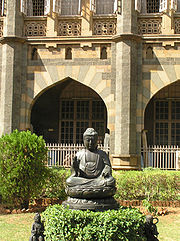 In 1904, some leading citizens of Bombay decided to provide a museum to commemorate the visit of the Prince of Wales
In 1904, some leading citizens of Bombay decided to provide a museum to commemorate the visit of the Prince of Wales
, the future King George V. On June 22, 1904, the committee passed a resolution saying, "The building should have a handsome and noble structure befitting the site selected, and in keeping with the best style of local architecture". The foundation stone was laid by the Prince of Wales on the 11 November 1905 and the museum was formally named "Prince of Wales Museum of Western India".
On March 1, 1907, the government of the Bombay Presidency
granted the museum committee a piece of land called the "Crescent Site", where the museum now stands. Following an open design competition, in 1909 the architect George Wittet
was commissioned to design the Museum building. Wittet had already worked on the design of the General Post Office and in 1911 would design one of Mumbai's most famous landmarks, the Gateway of India
.
The museum was funded by the Royal Visit (1905) Memorial Funds. Additionally, the Government and the Municipality granted Rs. 3 lacs and Rs. 2.5 lacs respectively. Sir Currimbhoy Ibrahim (first Baronet) donated another Rs. 3 lacs and Sir Cowasji Jehangir
, gave half a lac. The Museum was established under Bombay Act No. III of 1909. The museum is now maintained by annual grants from the Government and the Bombay Municipal Corporation. The latter pays for these grants from the interest accruing on the funds at the disposal of the Trust of the Museum.
The museum building was completed in 1915, but was used as a Children's Welfare Centre and a Military Hospital during the First World War, before being handed over to the committee in 1920. The Prince of Wales Museum was inaugurated on January 10, 1922, by Lady Lloyd, the wife of George Lloyd, Governor of Bombay.
The museum building is a Grade I Heritage Building of the city and was awarded the first prize (Urban Heritage Award) by the Bombay Chapter of Indian Heritage Society for heritage building maintenance, in 1990.
The Museum was renamed "Chhatrapati Shivaji Maharaj Vastu Sangrahalaya" after the founder of Maratha empire
- Shivaji, following the renaming of the city, when the colonial name "Bombay" was replaced by the native "Mumbai".
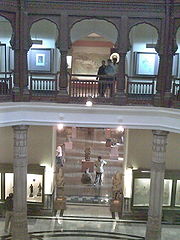 The museum building is situated in 3 acres (12,140.6 m²) area, having a built up area of 12,142.23 sq.m. The museum building is surrounded by a garden of palm trees and formal flower beds.
The museum building is situated in 3 acres (12,140.6 m²) area, having a built up area of 12,142.23 sq.m. The museum building is surrounded by a garden of palm trees and formal flower beds.
The museum building, built of basalt
and kurla stone, is a three-storied rectangular structure, capped by a dome set upon a base, which adds an additional storey in the centre of the building. Built in the Western Indian and Indo-Saracenic
style of architecture, the building accommodates a central entrance porch
, above which rises a dome, "tiled in white and blue flecks, supported on a lotus - petal base". A cluster of pinnacles, topped with miniature domes surround the central dome. The building incorporates features like Islamic dome with a finial
along with protruding balconies and inlaid floors, inspired by Mughal palace architecture
. The architect, George Wittet
, modeled the dome on that of Golconda Fort and the inner vaulting arches on those at the Gol Gumbaz
in Bijapur
. The interior of the museum combines the columns, railings and balcony of an 18th century Wada (a Maratha
mansion) with Jain style interior columns, which form the main body of the central pavilion
below the Maratha balcony.
In its recent modernization programme (2008), the Museum created 30000 sq ft (2,787.1 m²) space for installation of five new galleries, a conservation studio, a visiting exhibition gallery and a seminar room, in the East Wing of the Museum. The Museum also houses a library.
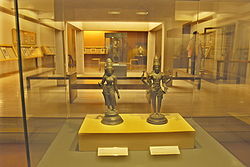 The museum collection comprises approximately 50,000 artefacts. The collection of the museum is categorized primarily into three sections: art, archaeology and natural history.
The museum collection comprises approximately 50,000 artefacts. The collection of the museum is categorized primarily into three sections: art, archaeology and natural history.
The museum also houses a forestry section, which has specimens of timbers grown in the Bombay Presidency
(British India), and one exhibiting a small local geological collection of rocks, minerals and fossils. The Maritime Heritage Gallery,which displays objects relating to navigation, is the "first of its kind in India". In 2008, the Museum installed two new galleries, displaying the "Karl and Meherbai Khandalavala collection" and "the Coins of India".
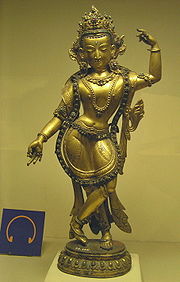 The museum's miniature collection encompasses representations of the main schools of Indian painting namely, Mughal, Rajasthani, Pahari and Deccani. It features palm leaf manuscripts dating to the 11th-12th centuries to the early 19th century pahari paintings, as well as paintings from the Sultanate period. Notable manuscripts housed in the museum include the Anwar-Suhayli painted in Mughal
The museum's miniature collection encompasses representations of the main schools of Indian painting namely, Mughal, Rajasthani, Pahari and Deccani. It features palm leaf manuscripts dating to the 11th-12th centuries to the early 19th century pahari paintings, as well as paintings from the Sultanate period. Notable manuscripts housed in the museum include the Anwar-Suhayli painted in Mughal
emperor Akbar’s studio and a 17th Century manuscript of the Hindu epic Ramayana
from Mewar
.
The ivory section has artefacts dating as early as the Gupta era. The museum also has decorative artefacts such as textiles, ivories, Mughal jades, silver, gold and artistic metal ware. It also has a collection of European paintings, Chinese and Japanese porcelain, ivory and jade artefacts. The museum also has sections dedicated to arms and armour and another to Nepali and Tibetan art
. The arms and armour section contains a finely decorated armour of Akbar dating to 1581 CE, consisting of a steel breastplate and a shield, the former inscribed with religious verses.
and the collections of the Bombay branch of the Royal Asiatic Society
resulted in the development of an archaeological section, with precious sculptures and epigram
s. The Indus Valley Culture Gallery houses fishing hooks, weapons, ornaments and weights and measures from the Indus Valley Civilization
(2600–1900 BCE). Artefacts from the excavation of the Buddhist stupa
of Mirpurkhas, were housed in the Museum in 1919. The sculpture collection holds Gupta
(280 to 550 CE) terracotta figures from Mirpurkhas in Sind
of the early 5th century, artefacts dating to the Chalukyan era (6th-12th century, Badami Chalukyas and Western Chalukyas
), and sculptures of the Rashtrakuta
period (753 – 982 CE) from Elephanta
, near Mumbai.
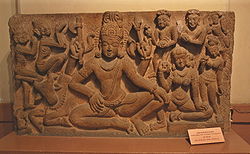 The Bombay Natural History Society
The Bombay Natural History Society
aided the Museum Trust in creating the natural history section. The museum's natural history section makes use of habitat group cases and diorama
s, along with diagrams and charts, to illustrate Indian wildlife, including flamingo
es, Great Hornbill
, Indian bison, and the tiger
.
was opened in March 2009. A textile gallery, the first gallery in the city, is going to be opened in April 2010. It will illustrate "various techniques of textile manufacturing, regional collections and traditional Indian costumes". Matrika Design Collaborative is currently designing the museum's Indian Miniature Painting Gallery. The content developed for the gallery will be converted into Braille text and tactile labels for the blind with help from designers, fabricators and consultants from the Hellen Keller Institute.
Mumbai
Mumbai , formerly known as Bombay in English, is the capital of the Indian state of Maharashtra. It is the most populous city in India, and the fourth most populous city in the world, with a total metropolitan area population of approximately 20.5 million...
, India was founded in the early years of the 20th century by some prominent citizens of Bombay, with the help of the government, to commemorate the visit of the then Prince of Wales. It is located in the heart of South Mumbai near the Gateway of India
Gateway of India
Its design is a combination of both Hindu and Muslim architectural styles, the arch is in Muslim style while the decorations are in Hindu style. The Gateway is built from yellow basalt and reinforced concrete. The stone was locally obtained, and the perforated screens were brought from Gwalior.The...
. The museum was renamed in the 1990s or early 2000s after Shivaji, the founder of Maratha Empire
Maratha Empire
The Maratha Empire or the Maratha Confederacy was an Indian imperial power that existed from 1674 to 1818. At its peak, the empire covered much of South Asia, encompassing a territory of over 2.8 million km²....
.
The museum building is built in the Indo-Saracenic
Indo-Saracenic
The Indo-Saracenic Revival was an architectural style movement by British architects in the late 19th century in British India...
style of architecture, incorporating elements of other styles of architecture like the Mughal, Maratha and Jain. The museum building is surrounded by a garden of palm trees and formal flower beds.
The museum houses approximately 50,000 exhibits of ancient Indian history as well as objects from foreign lands, categorized primarily into three sections: Art, Archaeology and Natural History. The museum houses Indus Valley Civilization
Indus Valley Civilization
The Indus Valley Civilization was a Bronze Age civilization that was located in the northwestern region of the Indian subcontinent, consisting of what is now mainly modern-day Pakistan and northwest India...
artefacts, and other relics from ancient India from the time of the Gupta
Gupta Empire
The Gupta Empire was an ancient Indian empire which existed approximately from 320 to 550 CE and covered much of the Indian Subcontinent. Founded by Maharaja Sri-Gupta, the dynasty was the model of a classical civilization. The peace and prosperity created under leadership of Guptas enabled the...
s, Maurya
Mauryan art
Mauryan art encompasses the arts produced during the period of the Mauryan Empire , which was the first empire to rule over most of the Indian subcontinent. It represented an important transition in Indian art from use of wood to stone...
s, Chalukyas and Rashtrakuta
Rashtrakuta
The Rashtrakuta Empire was a royal dynasty ruling large parts of the Indian Subcontinent between the sixth and the 10th centuries. During this period they ruled as several closely related, but individual clans. Rastrakutas in inscriptions represented as descendants of Satyaki, a Yadava well known...
.
History

Prince of Wales
Prince of Wales is a title traditionally granted to the heir apparent to the reigning monarch of the United Kingdom of Great Britain and Northern Ireland and the 15 other independent Commonwealth realms...
, the future King George V. On June 22, 1904, the committee passed a resolution saying, "The building should have a handsome and noble structure befitting the site selected, and in keeping with the best style of local architecture". The foundation stone was laid by the Prince of Wales on the 11 November 1905 and the museum was formally named "Prince of Wales Museum of Western India".
On March 1, 1907, the government of the Bombay Presidency
Bombay Presidency
The Bombay Presidency was a province of British India. It was established in the 17th century as a trading post for the English East India Company, but later grew to encompass much of western and central India, as well as parts of post-partition Pakistan and the Arabian Peninsula.At its greatest...
granted the museum committee a piece of land called the "Crescent Site", where the museum now stands. Following an open design competition, in 1909 the architect George Wittet
George Wittet
George Wittet was a Scottish architect who worked mostly in Bombay , India.-Life:George Wittet was born in Blair Atholl, Scotland in 1878. He studied architecture with a Mr...
was commissioned to design the Museum building. Wittet had already worked on the design of the General Post Office and in 1911 would design one of Mumbai's most famous landmarks, the Gateway of India
Gateway of India
Its design is a combination of both Hindu and Muslim architectural styles, the arch is in Muslim style while the decorations are in Hindu style. The Gateway is built from yellow basalt and reinforced concrete. The stone was locally obtained, and the perforated screens were brought from Gwalior.The...
.
The museum was funded by the Royal Visit (1905) Memorial Funds. Additionally, the Government and the Municipality granted Rs. 3 lacs and Rs. 2.5 lacs respectively. Sir Currimbhoy Ibrahim (first Baronet) donated another Rs. 3 lacs and Sir Cowasji Jehangir
Cowasji Jehangir
Sir Cowasji Jehangir, 2nd Baronet, GBE, KCIE was a prominent member of the Bombay Parsi community. He was the son of Sir Jehangir Cowasji Jehangir Readymoney, 1st Bt...
, gave half a lac. The Museum was established under Bombay Act No. III of 1909. The museum is now maintained by annual grants from the Government and the Bombay Municipal Corporation. The latter pays for these grants from the interest accruing on the funds at the disposal of the Trust of the Museum.
The museum building was completed in 1915, but was used as a Children's Welfare Centre and a Military Hospital during the First World War, before being handed over to the committee in 1920. The Prince of Wales Museum was inaugurated on January 10, 1922, by Lady Lloyd, the wife of George Lloyd, Governor of Bombay.
The museum building is a Grade I Heritage Building of the city and was awarded the first prize (Urban Heritage Award) by the Bombay Chapter of Indian Heritage Society for heritage building maintenance, in 1990.
The Museum was renamed "Chhatrapati Shivaji Maharaj Vastu Sangrahalaya" after the founder of Maratha empire
Maratha Empire
The Maratha Empire or the Maratha Confederacy was an Indian imperial power that existed from 1674 to 1818. At its peak, the empire covered much of South Asia, encompassing a territory of over 2.8 million km²....
- Shivaji, following the renaming of the city, when the colonial name "Bombay" was replaced by the native "Mumbai".
Architecture

The museum building, built of basalt
Basalt
Basalt is a common extrusive volcanic rock. It is usually grey to black and fine-grained due to rapid cooling of lava at the surface of a planet. It may be porphyritic containing larger crystals in a fine matrix, or vesicular, or frothy scoria. Unweathered basalt is black or grey...
and kurla stone, is a three-storied rectangular structure, capped by a dome set upon a base, which adds an additional storey in the centre of the building. Built in the Western Indian and Indo-Saracenic
Indo-Saracenic
The Indo-Saracenic Revival was an architectural style movement by British architects in the late 19th century in British India...
style of architecture, the building accommodates a central entrance porch
Porch
A porch is external to the walls of the main building proper, but may be enclosed by screen, latticework, broad windows, or other light frame walls extending from the main structure.There are various styles of porches, all of which depend on the architectural tradition of its location...
, above which rises a dome, "tiled in white and blue flecks, supported on a lotus - petal base". A cluster of pinnacles, topped with miniature domes surround the central dome. The building incorporates features like Islamic dome with a finial
Finial
The finial is an architectural device, typically carved in stone and employed decoratively to emphasize the apex of a gable or any of various distinctive ornaments at the top, end, or corner of a building or structure. Smaller finials can be used as a decorative ornament on the ends of curtain rods...
along with protruding balconies and inlaid floors, inspired by Mughal palace architecture
Mughal architecture
Mughal architecture, an amalgam of Islamic, Persian, Turkish and Indian architecture, is the distinctive style developed by the Mughals in the 16th, 17th and 18th centuries in what is now India, Pakistan, Bangladesh and Afghanistan. It is symmetrical and decorative in style.The Mughal dynasty was...
. The architect, George Wittet
George Wittet
George Wittet was a Scottish architect who worked mostly in Bombay , India.-Life:George Wittet was born in Blair Atholl, Scotland in 1878. He studied architecture with a Mr...
, modeled the dome on that of Golconda Fort and the inner vaulting arches on those at the Gol Gumbaz
Gol Gumbaz
Gol Gumbaz is the mausoleum of Mohammed Adil Shah, Sultan of Bijapur. The tomb, located in Bijapur, Karnataka in southern India, was completed in 1656 by the architect Yaqut of Dabul...
in Bijapur
Bijapur, Karnataka
Bijapur Urdu:بیجاپور city is the district headquarters of Bijapur District of Karnataka state. Bijapur city is well known for its historical monuments of architectural importance built during the rule of Adil Shahi dynasty...
. The interior of the museum combines the columns, railings and balcony of an 18th century Wada (a Maratha
Maratha
The Maratha are an Indian caste, predominantly in the state of Maharashtra. The term Marāthā has three related usages: within the Marathi speaking region it describes the dominant Maratha caste; outside Maharashtra it can refer to the entire regional population of Marathi-speaking people;...
mansion) with Jain style interior columns, which form the main body of the central pavilion
Pavilion (structure)
In architecture a pavilion has two main meanings.-Free-standing structure:Pavilion may refer to a free-standing structure sited a short distance from a main residence, whose architecture makes it an object of pleasure. Large or small, there is usually a connection with relaxation and pleasure in...
below the Maratha balcony.
In its recent modernization programme (2008), the Museum created 30000 sq ft (2,787.1 m²) space for installation of five new galleries, a conservation studio, a visiting exhibition gallery and a seminar room, in the East Wing of the Museum. The Museum also houses a library.
Collections

The museum also houses a forestry section, which has specimens of timbers grown in the Bombay Presidency
Bombay Presidency
The Bombay Presidency was a province of British India. It was established in the 17th century as a trading post for the English East India Company, but later grew to encompass much of western and central India, as well as parts of post-partition Pakistan and the Arabian Peninsula.At its greatest...
(British India), and one exhibiting a small local geological collection of rocks, minerals and fossils. The Maritime Heritage Gallery,which displays objects relating to navigation, is the "first of its kind in India". In 2008, the Museum installed two new galleries, displaying the "Karl and Meherbai Khandalavala collection" and "the Coins of India".
Art section
The art section displays the collections of Sir Purushottam Mavji, acquired in 1915, and the art collections of Sir Ratan Tata and Sir Dorab Tata, donated in 1921 and 1933 respectively.
Mughal Empire
The Mughal Empire , or Mogul Empire in traditional English usage, was an imperial power from the Indian Subcontinent. The Mughal emperors were descendants of the Timurids...
emperor Akbar’s studio and a 17th Century manuscript of the Hindu epic Ramayana
Ramayana
The Ramayana is an ancient Sanskrit epic. It is ascribed to the Hindu sage Valmiki and forms an important part of the Hindu canon , considered to be itihāsa. The Ramayana is one of the two great epics of India and Nepal, the other being the Mahabharata...
from Mewar
Mewar
Mewar is a region of south-central Rajasthan state in western India. It includes the present-day districts of Pratapgarh, Bhilwara, Chittorgarh, Rajsamand, Udaipur, Dungarpur, Banswara and some of the part of Gujarat and Madhya Pradesh. The region was for centuries a Rajput kingdom that later...
.
The ivory section has artefacts dating as early as the Gupta era. The museum also has decorative artefacts such as textiles, ivories, Mughal jades, silver, gold and artistic metal ware. It also has a collection of European paintings, Chinese and Japanese porcelain, ivory and jade artefacts. The museum also has sections dedicated to arms and armour and another to Nepali and Tibetan art
Tibetan art
Tibetan art refers to the art of Tibet. For more than a thousand years, Tibetan artists have played a key role in the cultural life of Tibet. From designs for painted furniture to elaborate murals in religious buildings, their efforts have permeated virtually every facet of life on the Tibetan...
. The arms and armour section contains a finely decorated armour of Akbar dating to 1581 CE, consisting of a steel breastplate and a shield, the former inscribed with religious verses.
Archaeological section
Sculptures and coins transferred from the Poona Museum in PunePune
Pune , is the eighth largest metropolis in India, the second largest in the state of Maharashtra after Mumbai, and the largest city in the Western Ghats. Once the centre of power of the Maratha Empire, it is situated 560 metres above sea level on the Deccan plateau at the confluence of the Mula ...
and the collections of the Bombay branch of the Royal Asiatic Society
Royal Asiatic Society
The Royal Asiatic Society of Great Britain and Ireland was established, according to its Royal Charter of 11 August 1824, to further "the investigation of subjects connected with and for the encouragement of science, literature and the arts in relation to Asia." From its incorporation the Society...
resulted in the development of an archaeological section, with precious sculptures and epigram
Epigram
An epigram is a brief, interesting, usually memorable and sometimes surprising statement. Derived from the epigramma "inscription" from ἐπιγράφειν epigraphein "to write on inscribe", this literary device has been employed for over two millennia....
s. The Indus Valley Culture Gallery houses fishing hooks, weapons, ornaments and weights and measures from the Indus Valley Civilization
Indus Valley Civilization
The Indus Valley Civilization was a Bronze Age civilization that was located in the northwestern region of the Indian subcontinent, consisting of what is now mainly modern-day Pakistan and northwest India...
(2600–1900 BCE). Artefacts from the excavation of the Buddhist stupa
Stupa
A stupa is a mound-like structure containing Buddhist relics, typically the remains of Buddha, used by Buddhists as a place of worship....
of Mirpurkhas, were housed in the Museum in 1919. The sculpture collection holds Gupta
Gupta Empire
The Gupta Empire was an ancient Indian empire which existed approximately from 320 to 550 CE and covered much of the Indian Subcontinent. Founded by Maharaja Sri-Gupta, the dynasty was the model of a classical civilization. The peace and prosperity created under leadership of Guptas enabled the...
(280 to 550 CE) terracotta figures from Mirpurkhas in Sind
History of Sindh
Sindh is one of the provinces of Pakistan. Sindh was home to one of the world's oldest civilizations, the Indus Valley civilization.-Paleolithic and Mesolithic era:...
of the early 5th century, artefacts dating to the Chalukyan era (6th-12th century, Badami Chalukyas and Western Chalukyas
Western Chalukyas
The Western Chalukya Empire ruled most of the western Deccan, South India, between the 10th and 12th centuries. This dynasty is sometimes called the Kalyani Chalukya after its regal capital at Kalyani, today's Basavakalyan in Karnataka and alternatively the Later Chalukya from its theoretical...
), and sculptures of the Rashtrakuta
Rashtrakuta
The Rashtrakuta Empire was a royal dynasty ruling large parts of the Indian Subcontinent between the sixth and the 10th centuries. During this period they ruled as several closely related, but individual clans. Rastrakutas in inscriptions represented as descendants of Satyaki, a Yadava well known...
period (753 – 982 CE) from Elephanta
Elephanta Caves
The Elephanta Caves are a network of sculpted caves located on Elephanta Island, or Gharapuri in Mumbai Harbour, to the east of the city of Mumbai in the Indian state of Maharashtra...
, near Mumbai.
Natural History section

Bombay Natural History Society
The Bombay Natural History Society, founded on 15 September 1883, is one of the largest non-governmental organizations in India engaged in conservation and biodiversity research. It supports many research efforts through grants, and publishes the Journal of the Bombay Natural History Society. Many...
aided the Museum Trust in creating the natural history section. The museum's natural history section makes use of habitat group cases and diorama
Diorama
The word diorama can either refer to a nineteenth century mobile theatre device, or, in modern usage, a three-dimensional full-size or miniature model, sometimes enclosed in a glass showcase for a museum...
s, along with diagrams and charts, to illustrate Indian wildlife, including flamingo
Flamingo
Flamingos or flamingoes are gregarious wading birds in the genus Phoenicopterus , the only genus in the family Phoenicopteridae...
es, Great Hornbill
Great Hornbill
The Great Hornbill also known as Great Indian Hornbill or Great Pied Hornbill, is one of the larger members of the hornbill family. Great Hornbills are found in the forests of Nepal, India, the Malay Peninsula and Sumatra, Indonesia. Their impressive size and colour have made them important in...
, Indian bison, and the tiger
Tiger
The tiger is the largest cat species, reaching a total body length of up to and weighing up to . Their most recognizable feature is a pattern of dark vertical stripes on reddish-orange fur with lighter underparts...
.
New galleries
As part of renovation project initiated in October 2008, the "Krishna Gallery" holding artworks related to the Hindu god KrishnaKrishna
Krishna is a central figure of Hinduism and is traditionally attributed the authorship of the Bhagavad Gita. He is the supreme Being and considered in some monotheistic traditions as an Avatar of Vishnu...
was opened in March 2009. A textile gallery, the first gallery in the city, is going to be opened in April 2010. It will illustrate "various techniques of textile manufacturing, regional collections and traditional Indian costumes". Matrika Design Collaborative is currently designing the museum's Indian Miniature Painting Gallery. The content developed for the gallery will be converted into Braille text and tactile labels for the blind with help from designers, fabricators and consultants from the Hellen Keller Institute.

